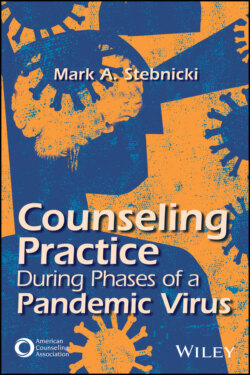Читать книгу Counseling Practice During Phases of a Pandemic Virus - Mark A. Stebnicki - Страница 45
Level 2 = Fair Resiliency
ОглавлениеLevel 2 individuals have fair mental, behavioral, and psychosocial health. The individual has very little respect for the seriousness, lethality, and consequences of a pandemic virus. They are generally compliant with virus hygiene protocols such as wearing a mask, washing their hands, and keeping a distance but only in social situations that mandate this. Level 2 individuals imply “I won’t live my life in fear of a virus.” Thus, there is some minimization of the seriousness, lethality, and consequences of a pandemic virus. Individuals at Level 2 do not view good virus hygiene practices as totally necessary and do not totally endorse adherence to public health guidelines for the protection of themselves and others through immunization. Individuals at Level 2 may experience and react with irrational fear and anxiety; however, this is directed more toward their changing environment, which they do not understand, recognize, or feel they have control over because of a pandemic disaster. Individuals at Level 2 are more affected by trigger events (e.g., media reporting of positive COVID-19 cases, COVID-related illnesses and deaths, school and workplace closures) and form their pandemic ideology based on events that may or may not directly impact their lives. Clinically significant psychological/emotional symptoms and conditions are not dealt with in a therapeutic manner, and therapeutic interventions are resisted. The individual does not exhibit stress-hardy behaviors. It may take them longer to bounce back from adversity compared to individuals at Level 3. Individuals at Level 2 do not endorse public health principles, practices, guidelines, and government mandates associated with a pandemic disaster. They view good virus hygiene and adherence to public health guidelines as nonessential to the protection of themselves and others. They do not recognize the importance of public health guidance and government mandates. Thus, persons at Level 2 take many more virus hygiene risks than persons at Level 3. Individuals at Level 2 struggle with balance, adaptation, and adjustment in relation to their changing pandemic environment. They typically do not have the capacity to respond to the grief, loss, and extraordinary stressful and/or traumatic events associated with a pandemic virus because they are much too internally focused on their unhealthy thoughts, feelings, and cognitions. Persons at Level 2 struggle with balancing the reality of a pandemic disaster with other life responsibilities. They cannot move forward because of life circumstances related to their medical, physical, and mental health conditions. Persons at Level 2 also have academic, job, career, relational, financial, and other hardships that may be beyond their control. Their overall mental and physical well-being is compromised by their inability to cope with adversity. Persons at Level 2 find very little meaning in their existence and find it difficult to gain relief during phases of a pandemic disaster. Adjustment and adaptation to the overall effects of a pandemic virus are difficult for persons at Level 2 because they struggle with a path forward to overall health and well-being. The mental, behavioral, psychosocial, and medical/physical health of the individual at Level 2 is demonstrated by the following.
